About fiber optic transceivers
The optical fiber transceiver is an Ethernet transmission media conversion unit that exchanges short-distance twisted-pair electrical signals and long-distance optical signals. It is also called a fiber converter in many places. Products are generally used in actual network environments where Ethernet cables cannot be covered and optical fibers must be used to extend the transmission distance, and are usually positioned in the access layer application of broadband metropolitan area networks.
The role of fiber optic transceivers
Fiber optic transceivers are generally used in actual network environments where Ethernet cables cannot be covered and optical fibers must be used to extend the transmission distance. At the same time, they have also played a huge role in helping to connect the last mile of optical fiber lines to metropolitan area networks and outer networks. The role of. The function of the fiber optic transceiver is to convert the electrical signal we want to send into an optical signal and send it out. At the same time, it can convert the received optical signal into an electrical signal and input it to our receiving end.
Classification of fiber optic transceivers
1.Single-mode fiber optic transceiver: transmission distance from 20 kilometers to 120 kilometers.
2.Multimode fiber optic transceiver: transmission distance of 2 kilometers to 5 kilometers.
For example, the transmit power of a 5km fiber optic transceiver is generally between -20 and -14db, and the receiving sensitivity is -30db, using a wavelength of 1310nm; while the transmit power of a 120km fiber optic transceiver is mostly between -5 and 0dB, and the receiving sensitivity For -38dB, use a wavelength of 1550nm.
Features of fiber optic transceivers
Fiber optic transceivers usually have the following basic characteristics:
1. Provide ultra-low latency data transmission.
2. Fully transparent to the network protocol.
3. Use dedicated ASIC chip to realize data line-speed forwarding. Programmable ASIC concentrates multiple functions on one chip, and has the advantages of simple design, high reliability, and low power consumption, which can enable equipment to obtain higher performance and lower cost.
4. Rack-type equipment can provide hot-swappable function for easy maintenance and uninterrupted upgrades.
5. The network management equipment can provide functions such as network diagnosis, upgrade, status report, abnormal situation report and control, and can provide a complete operation log and alarm log.
6. Most equipment adopts 1+1 power supply design, supports ultra-wide power supply voltage, and realizes power supply protection and automatic switching.
7. Support an ultra-wide working temperature range.
8. Support complete transmission distance (0~120 kilometers).
Advantages of fiber optic transceivers
When it comes to fiber optic transceivers, people often unavoidably compare fiber optic transceivers with switches with optical ports. The following mainly talks about the advantages of fiber optic transceivers over optical port switches.
First of all, the price of fiber optic transceivers plus ordinary switches is far cheaper than optical switches, especially some optical switches will lose one or even several electrical ports after adding optical modules, which can make operators to a large extent Reduce upfront investment.
Secondly, since most of the optical modules of the switches do not have a unified standard, once the optical modules are damaged, they need to be replaced with the same modules from the original manufacturer, which brings great trouble to the later maintenance.However, there is no problem with the interconnection and intercommunication between equipment of different manufacturers of fiber optic transceivers, so once it is damaged, it can be replaced with other manufacturers’ products, which is very easy to maintain.
In addition, fiber optic transceivers have more complete products than optical port switches in terms of transmission distance. Of course, the optical switch also has advantages in many aspects, such as unified management and unified power supply.
